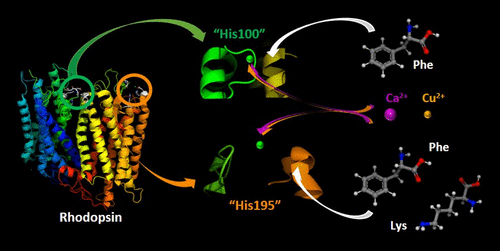当前位置:
X-MOL 学术
›
Inorg. Chem.
›
论文详情
Our official English website, www.x-mol.net, welcomes your
feedback! (Note: you will need to create a separate account there.)
Zinc and Its Critical Role in Retinitis pigmentosa: Insights from DFT/SMD Calculations
Inorganic Chemistry ( IF 4.3 ) Pub Date : 2020-11-20 , DOI: 10.1021/acs.inorgchem.0c02664 Nikoleta Kircheva 1 , Stefan Dobrev 1 , Valya Nikolova 2 , Silvia Angelova 1 , Todor Dudev 2
Inorganic Chemistry ( IF 4.3 ) Pub Date : 2020-11-20 , DOI: 10.1021/acs.inorgchem.0c02664 Nikoleta Kircheva 1 , Stefan Dobrev 1 , Valya Nikolova 2 , Silvia Angelova 1 , Todor Dudev 2
Affiliation

|
Metal cations are required for the proper function of a great amount of biological processes, as they are indispensable cofactors participating in up to 40% of the active sites of the proteins. In the case of some diseases, however, metal cations could exhibit a dual function. As an example, the role of the zinc cation in the development of Retinitis pigmentosa could be given. Experimental works indicate the loss of thermostability of the rhodopsin protein, subjected to the combination of—typical for the disease—mutations and increased quantity of Zn2+. Two structural networks in the intradiscal domain surrounding His100 and His195 are supposed to be susceptible to pathophysiological changes in trace metal concentrations. From a thermodynamic point of view, it is of particular interest to decipher the foundations of the observed outcome, as well as to closely characterize the intimate interactions between the “native” cation and the building amino acid residues of the studied centers. Therefore, the powerful, but fundamentally limited, tools of computational chemistry were applied on simplified models of rhodopsin metal centers in order to shed light on the following aspects: (1) what is the preferred geometry of the Zn2+-containing complexes with the amino acid ligands from the binding pockets; (2) what is the role of the mutations for the interactions between Zn2+ and the examined centers; (3) could other divalent cations such as Ca2+ and Cu2+ substitute for the native zinc; (4) how does the dielectric constant of the environment affect the processes? The obtained results illuminate some aspects of the zinc coordination to amino acid residues and zinc biochemistry related to the presumed pathogenesis of Retinitis pigmentosa.
中文翻译:

锌及其在色素性视网膜炎中的关键作用:DFT / SMD计算的见解
金属阳离子是大量生物学过程的正常功能所必需的,因为它们是参与蛋白质高达40%活性位点的必不可少的辅助因子。但是,在某些疾病中,金属阳离子可能具有双重功能。例如,可以给出锌阳离子在色素性视网膜炎的发展中的作用。实验工作表明,视紫红质蛋白的热稳定性丧失,受到该疾病典型的突变和Zn 2+数量增加的共同作用。围绕His100和His195的盘内域中的两个结构网络被认为对痕量金属浓度的病理生理变化敏感。从热力学观点来看,破译观察到的结果的基础,以及密切表征“天然”阳离子与研究中心的建筑氨基酸残基之间的紧密相互作用特别有意义。因此,将功能强大但从根本上来说有限的计算化学工具应用于视紫红质金属中心的简化模型,以阐明以下方面:(1)Zn 2+的优选几何形状是什么与来自结合袋的氨基酸配体的含复合物;(2)突变对于Zn 2+与受检中心之间相互作用的作用是什么?(3)其他二价阳离子如Ca 2+和Cu 2+可以代替天然锌吗?(4)环境的介电常数如何影响过程?获得的结果阐明了锌与氨基酸残基的配位和锌生化的一些方面与色素性视网膜炎的发病机制有关。
更新日期:2020-12-07
中文翻译:

锌及其在色素性视网膜炎中的关键作用:DFT / SMD计算的见解
金属阳离子是大量生物学过程的正常功能所必需的,因为它们是参与蛋白质高达40%活性位点的必不可少的辅助因子。但是,在某些疾病中,金属阳离子可能具有双重功能。例如,可以给出锌阳离子在色素性视网膜炎的发展中的作用。实验工作表明,视紫红质蛋白的热稳定性丧失,受到该疾病典型的突变和Zn 2+数量增加的共同作用。围绕His100和His195的盘内域中的两个结构网络被认为对痕量金属浓度的病理生理变化敏感。从热力学观点来看,破译观察到的结果的基础,以及密切表征“天然”阳离子与研究中心的建筑氨基酸残基之间的紧密相互作用特别有意义。因此,将功能强大但从根本上来说有限的计算化学工具应用于视紫红质金属中心的简化模型,以阐明以下方面:(1)Zn 2+的优选几何形状是什么与来自结合袋的氨基酸配体的含复合物;(2)突变对于Zn 2+与受检中心之间相互作用的作用是什么?(3)其他二价阳离子如Ca 2+和Cu 2+可以代替天然锌吗?(4)环境的介电常数如何影响过程?获得的结果阐明了锌与氨基酸残基的配位和锌生化的一些方面与色素性视网膜炎的发病机制有关。











































 京公网安备 11010802027423号
京公网安备 11010802027423号